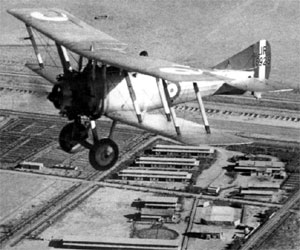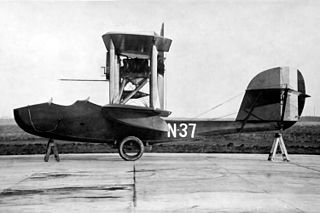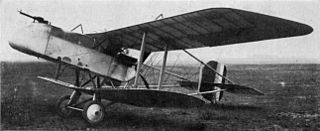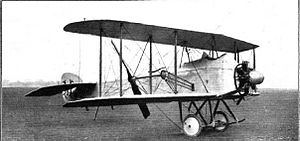The Aircraft Manufacturing Company Limited (Airco) was an early British aircraft manufacturer. Established during 1912, it grew rapidly during the First World War, referring to itself as the largest aircraft company in the world by 1918.

The Vickers F.B.5 was a British two-seat pusher military biplane of the First World War. Armed with a single .303 in (7.7 mm) Lewis gun operated by the observer in the front of the nacelle, it was the first aircraft purpose-built for air-to-air combat to see service, making it the world's first operational fighter aircraft.

The Polikarpov I-153 Chaika was a late 1930s Soviet sesquiplane fighter. Developed from the I-15 with a retractable undercarriage, the I-153 fought in the Soviet-Japanese combats in Mongolia and was one of the Soviets' major fighter types in the early years of the Second World War. Three I-153s are in flying condition.

The Airco DH.5 was a British First World War single-seat biplane fighter aircraft. It was designed and manufactured at British aviation company Airco. Development was led by aircraft designer Geoffrey de Havilland as a replacement for the obsolete Airco DH.2.

The Supermarine P.B.31E Nighthawk was a British aircraft of the First World War and the first project of the Pemberton-Billing operation after it became Supermarine Aviation Works Ltd. It was an anti-Zeppelin night fighter operated by a crew of three to five and had a planned flight endurance of 9–18 hours. The prototype flew in February 1917 with Clifford Prodger at the controls. It proved to not meet the promised specification and no more were built.

The Nieuport Nighthawk was a British fighter aircraft developed by the Nieuport & General Aircraft company for the Royal Air Force towards the end of the First World War. Although ordered into production before the aircraft first flew, it did not enter large scale service with the RAF owing to unreliable engines. Re-engined aircraft did see service in Greece, serving from 1923 to 1938.

The Vickers F.B.12 was a biplane pusher fighter aircraft developed during World War I by Vickers Limited. The failure of the engine for which it was designed, and the obsolescence of the pusher configuration, resulted in its remaining an experimental type only.
The Sopwith Snapper was a prototype British fighter aircraft of the First World War. A single-engined biplane designed by the Sopwith Aviation Company to replace the Sopwith Snipe fighter, it first flew after the end of the war, but did not enter service owing to the failure of its engine, only three aircraft being built.
The Sopwith 2FR.2 Bulldog was a prototype British two-seat fighter of the First World War. A single-engined biplane, the Bulldog was a fighter/reconnaissance aircraft intended to replace the Bristol F.2 Fighter, but was unsuccessful, with no replacement for the Bristol Fighter being purchased.

The Norman Thompson N.1B was a prototype British flying boat fighter aircraft of the First World War. A two-seat single-engined pusher biplane, a single example was built in 1917, but no production followed.
The Vickers E.F.B.8 was a prototype British twin-engined fighter of the First World War. It was abandoned after only one aircraft was built, single-engined fighters being considered to have superior manoeuvrability.
The Sopwith Gunbus was a British fighter aircraft of the First World War. It was a single-engined pusher biplane based on a floatplane built by Sopwith before the war for Greece. Small numbers were built and used by the British Royal Naval Air Service, mainly as a trainer.

The Royal Aircraft Factory F.E.9 was a prototype British two-seat fighter-reconnaissance aircraft of the First World War. A single-engined pusher biplane of 1917, the F.E.9 had poor performance and handling, and only three were built.
The Sopwith Snark was a British prototype fighter aircraft designed and built towards the end of the First World War to replace the RAF's Sopwith Snipes. A single engined triplane, the Snark did not fly until after the end of the war, only three being built.
The Royal Aircraft Factory C.E.1 was a prototype British flying boat of the First World War. It was a single-engined pusher configuration biplane intended to carry out coastal patrols to protect shipping against German U-boats, but only two were built, the only flying boats to be designed and built by the Royal Aircraft Factory.

The Vickers F.B.16 was a British single-seat fighter aircraft of the First World War. It was originally designed to be powered by an experimental radial engine, development of which was abandoned. When re-engined with more powerful and reliable water-cooled V-8 engines, the F.B.16 demonstrated good performance, but only a few prototypes were built, the type not entering service.

The Vickers F.B.25 was a British two-seat night fighter prototype of World War I designed to attack enemy airships. Completed in 1917, it failed in its official flight tests that year and no order for production resulted.
The Hanriot HD.6 was a French two-seat fighter aircraft prototype, built towards the end of World War I though not flown until after the armistice with Germany. A biplane with an unusually narrow gap between upper and lower wings, powered by a single water-cooled radial engine, it did not enter production.
The Weymann W-1 was a French single seat biplane fighter aircraft, built during World War I. It had a most unusual layout, with an engine buried in the fuselage driving a pusher configuration propeller behind a cruciform tail. It was not successful and soon abandoned.

The Caudron Type A was the first successful aircraft built by René Caudron and his brother Gaston. During 1910 the Caudron brothers were briefly associated with the Société Anonyme Français d'Aviation (S.A.F.A.), and an example of the type was exhibited at the 1910 Paris Aero Salon as the S.A.F.A. Biplane.











